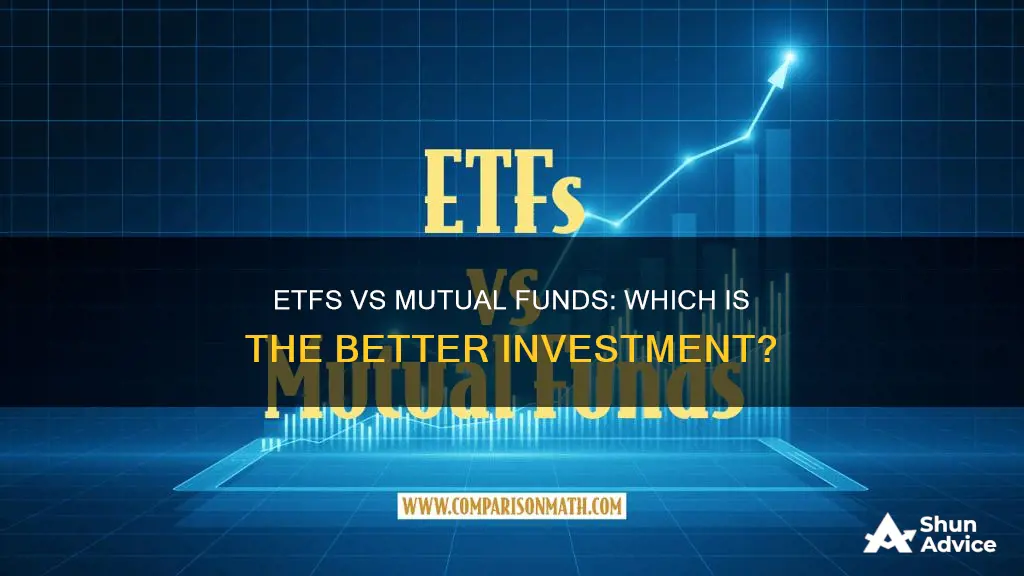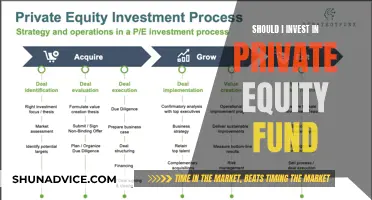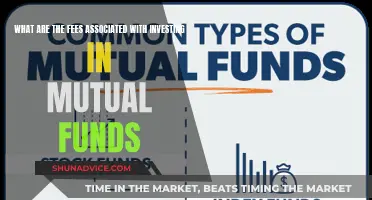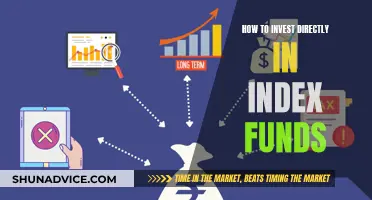
Exchange-traded funds (ETFs) and mutual funds are both investment vehicles that can help you save for retirement. They both involve less risk than investing in individual securities. But what are ETFs and mutual funds, and which is better?
The main difference between ETFs and mutual funds is that an ETF's price is based on the market price and is sold only in full shares, whereas mutual funds are sold based on dollars, so you can specify any dollar amount you'd like to invest. ETFs are also usually traded throughout the day, whereas mutual funds are usually priced and traded at the end of each trading day. ETFs are also generally cheaper than mutual funds.
| Characteristics | Values |
|---|---|
| Initial Investment | ETFs usually have a lower minimum initial investment than mutual funds. |
| Management | Mutual funds are actively managed, while ETFs are passively managed. |
| Trading | ETFs are traded throughout the day, while mutual funds are traded once a day. |
| Pricing | ETFs are priced based on the market price, while mutual funds are sold based on dollars. |
| Tax | ETFs are more tax-efficient than mutual funds. |
What You'll Learn
- ETFs are bought and sold on an exchange throughout the day, while mutual funds can be bought or sold only once a day at the latest closing price
- ETFs are usually passively managed, while mutual funds are actively managed
- ETFs are more tax-efficient than mutual funds
- Mutual funds have higher minimum initial investments than ETFs
- ETFs are cheaper than mutual funds

ETFs are bought and sold on an exchange throughout the day, while mutual funds can be bought or sold only once a day at the latest closing price
One of the most significant differences between ETFs and mutual funds is their tradability. ETFs (exchange-traded funds) are bought and sold on an exchange throughout the trading day, whereas mutual funds can only be bought or sold once a day at the latest closing price. This is because ETFs are traded like stocks, with their prices based on supply and demand. On the other hand, mutual funds are priced and traded at the end of each trading day, and the price is based on the net asset value of the fund.
This difference has several implications for investors. Firstly, it means that ETFs offer more flexibility in terms of when you can buy or sell your investment. If you need to access your money quickly, an ETF may be a better option as you can sell during the trading day. Secondly, the ability to trade throughout the day means that ETFs offer more sophisticated order types, giving you more control over the price you buy or sell at. This makes ETFs a better choice for active traders. However, it's important to note that while ETFs can be traded throughout the day, they are not usually intended for day trading, and some brokers charge a fee if you don't hold an ETF for a certain number of days.
The tradability of ETFs also has tax implications. ETFs are generally more tax-efficient than mutual funds because they are usually passively managed, with less internal trading, resulting in fewer taxable events. With ETFs, you only pay capital gains taxes when you sell your shares, whereas with mutual funds, you may have to pay taxes on capital gains distributed by the fund, even if you haven't sold your shares.
In addition to the differences in tradability, there are several other factors that distinguish ETFs and mutual funds. ETFs tend to be passively managed, meaning they track a pre-selected index, while mutual funds are often actively managed, with a fund manager trying to beat the market. Actively managed funds tend to have higher fees and expense ratios due to their higher operating costs. ETFs also usually have lower minimum investment requirements, as they can be purchased by the share, whereas mutual funds often have minimum initial investments of hundreds or thousands of dollars.
A Beginner's Guide to Vanguard Mutual Funds Investing
You may want to see also

ETFs are usually passively managed, while mutual funds are actively managed
Exchange-traded funds (ETFs) and mutual funds are both investment vehicles that pool investor money into a collection of securities, exposing investors to many different securities without having to purchase and manage them. However, they differ in how they are managed.
ETFs are usually passively managed, meaning their holdings track a preset index of securities. In other words, they are index funds with a twist. They are designed to match the returns and price movements of an index, such as the S&P 500 or the Nasdaq 100. The return on investment should be nearly identical to the return of the index.
Mutual funds, on the other hand, are commonly actively managed. This means that a fund manager makes decisions about how to allocate assets to try to beat the market and help investors profit. Actively managed funds incur high costs for analysts, economic and industry research, company visits, and administration. Mutual funds can also be passively managed, but this is less common.
The different management styles have implications for the investor in terms of costs and potential returns. Passively managed ETFs are relatively inexpensive, with some carrying expense ratios as low as 0.03%. In contrast, the average annual expense ratio of actively managed funds was 0.59% in 2023. Actively managed funds may also ding your returns by running up your tax bill, as they trade in and out of the market more frequently, creating more taxable events.
The different management styles also affect the liquidity of the investment. ETFs are traded on exchanges like stocks and can be bought and sold throughout the trading day. Mutual funds, however, can only be bought or sold once a day at the latest closing price.
International Equity Funds: Smart Investment or Risky Business?
You may want to see also

ETFs are more tax-efficient than mutual funds
Exchange-traded funds (ETFs) are generally considered to be more tax-efficient than mutual funds. This is due to their unique structure and the way they are created and redeemed, which results in fewer "taxable events" and, therefore, fewer opportunities for taxation.
Firstly, ETFs have a mechanism called
Secondly, ETFs are mostly passively managed, which means their portfolios only change when the underlying index they replicate changes. Actively managed mutual funds, on the other hand, experience taxable events when selling the assets within them, and their higher turnover results in higher capital gains.
ETFs' unique in-kind creation and redemption process also helps them avoid realising capital gains. This, along with their typically lower turnover rates, makes them more tax-efficient than mutual funds.
It is important to note that the specific structure of an ETF can impact its tax efficiency, and certain types of ETFs, such as those focused on emerging markets or using derivatives, may be less tax-efficient than traditional mutual funds.
Additionally, while ETFs are generally more tax-efficient, both investment vehicles are subject to similar tax considerations. Both are taxed on dividends and capital gains distributions, as well as gains from market transactions. The tax treatment of these is based on whether the investment was held short-term or long-term.
The 'What If' Investment Calculator: Your Potential Future
You may want to see also

Mutual funds have higher minimum initial investments than ETFs
Mutual funds and ETFs are both investment vehicles that pool investor money into a collection of securities, providing investors with exposure to a wide range of securities without having to purchase and manage them individually. However, mutual funds and ETFs differ in several key ways, one of which is their minimum initial investment requirements.
Mutual funds typically have higher minimum initial investment requirements than ETFs. While ETFs can be purchased by the share, with the cost of a single share potentially being as little as $1, mutual funds often require a minimum initial investment of hundreds or thousands of dollars. For example, Vanguard mutual funds have a $3,000 minimum initial investment requirement. This difference is due to the fact that mutual fund minimum initial investments are based on a flat dollar amount, whereas ETFs can be purchased for the price of a single share.
The higher minimum initial investment requirements of mutual funds can be a barrier for investors with limited funds, making ETFs a more accessible option for those looking to get started with a smaller amount of money. However, it is important to note that some mutual funds do not have minimum initial investment requirements, and there may be ETFs with higher share prices that require a larger initial investment.
In addition to the higher minimum initial investment requirements of mutual funds, there are other differences between the two investment options. Mutual funds are typically actively managed, meaning they aim to beat the market by buying and selling stocks using the expertise of a professional fund manager. This active management often results in higher costs for investors. ETFs, on the other hand, are usually passively managed, meaning they automatically track a pre-selected index. While actively managed funds may outperform ETFs in the short term, long-term results often show lower returns for actively managed mutual funds due to higher expense ratios and the difficulty of consistently beating the market.
Another difference between mutual funds and ETFs lies in their tax efficiency. ETFs are generally more tax-efficient than mutual funds because they are passively managed and incur less frequent capital gains taxes. In contrast, mutual funds are actively managed, resulting in more frequent buying and selling of assets, which can trigger capital gains taxes for investors even if they have not sold their shares.
Furthermore, mutual funds and ETFs differ in their trading structure. ETFs are traded throughout the day like stocks, with their prices based on supply and demand. On the other hand, mutual funds are priced and traded at the end of each trading day. This means that investors in mutual funds will always receive the net asset value of the fund, while ETF investors may pay a premium or discount depending on market demand.
In summary, mutual funds and ETFs offer investors similar benefits in terms of diversification and professional management. However, they differ in several key ways, including minimum initial investment requirements, management style, tax efficiency, and trading structure. These differences can impact an investor's returns, costs, and flexibility, so it is important to carefully consider these factors when deciding between mutual funds and ETFs.
Stocks vs Mutual Funds: Where to Invest Your Money?
You may want to see also

ETFs are cheaper than mutual funds
Exchange-traded funds (ETFs) are generally cheaper than mutual funds. ETFs are often passively managed, meaning their holdings track a preset index of securities rather than having a portfolio manager picking them. On the other hand, mutual funds are usually actively managed, meaning they are trying to beat their benchmark. This active management comes with higher expenses than ETFs, including the possibility of sales commissions.
Mutual funds charge their shareholders for everything that goes on inside the fund, such as transaction fees, distribution charges, and transfer-agent costs. They also pass along their capital gains tax bill on an annual basis. These costs decrease the shareholder's after-tax return on their investment. Many funds also charge a sales load, which can range from 1% to 2%. ETFs, on the other hand, are more transparent and have fewer fees.
Mutual funds typically have minimum initial purchase requirements, whereas ETFs usually do not. ETFs can be purchased for the price of one share, which can be as little as $50 or a few hundred dollars. Mutual funds, on the other hand, have a flat-rate minimum initial investment, which is often much higher than the price of one ETF share.
ETFs are also more flexible than mutual funds. They can be bought and sold throughout the trading day, like stocks, whereas mutual funds can only be purchased at the end of each trading day. This gives the investor more control over the price of their trade.
Overall, ETFs are a more affordable option than mutual funds, with lower fees, minimum investments, and more trading flexibility.
Mutual Funds: Where Are Your Investments Going?
You may want to see also
Frequently asked questions
The main difference is that ETFs are traded throughout the day like stocks, whereas mutual funds are priced and traded at the end of each trading day.
ETFs are great for first-time investors of any age. They are professionally managed, traded throughout the day on exchanges, and there is no minimum investment because they trade as shares. Mutual funds can also be a good option for beginners because they are affordable, and many don't set a required minimum investment.
ETFs are usually passively managed and tend to be more tax-efficient than mutual funds, so they are often a better option for long-term investing. However, if the mutual fund is held in a tax-advantaged account, the tax implications of ETFs vs. mutual funds are irrelevant.







